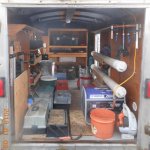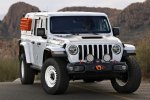Over here the JL’s with tow package spec the 240 amp alternator.Yes, mine is factory advertised as 240Amp.
I don't know if that's because it's a Rubicon and/or because it's Australian spec.
-Dan
You are using an out of date browser. It may not display this or other websites correctly.
You should upgrade or use an alternative browser.
You should upgrade or use an alternative browser.
The Oversleeper
- Thread starter 86scotty
- Start date
Dan Grec
Expedition Leader
Nice system. Once again, I am not an electrical whiz but from what I have gathered in reading up on in line dual zone Solar / DC-DC chargers both your crank battery and your "house" battery need to be of the same type, either lithium to lithium of AGM to AGM or lead to lead. Maybe I am missing something in my research. Or maybe it has to do with the way they are isolated or not in the systems I have read about.
That is definitely not true with this DC/DC charger with solar built in. The charger is only using the DC/DC feature to charge the Lithium (and you tell it what kind it's charging - it's configurable), and then trickle charging the starter sometimes.
Requiring the same kind of battery is true of the "old school" way of doing dual isolated batteries where there is a huge solenoid that bridges them together (effectively making them one battery). I had that kind of system in my Africa Jeep, and I believe that is how the Genesis system works. It's also very in-efficient and slow because it just relies on the alternator to charge up the "one big battery", which is not something alternators are great at if the battery is a bit low.
That why I called my setup 21st century dual isolated batteries - it's the much better way of doing it.
-Dan
Jay61
Member
Thanks for clearing that up for me, because I was a little miffed by what I was seeing on You-Tube and online plus what I was being told by Genesis. Once again I am not an electronics whiz and pretty much have to rely upon what I am finding on the internet for my ad hoc education on the issue.That is definitely not true with this DC/DC charger with solar built in. The charger is only using the DC/DC feature to charge the Lithium (and you tell it what kind it's charging - it's configurable), and then trickle charging the starter sometimes.
Requiring the same kind of battery is true of the "old school" way of doing dual isolated batteries where there is a huge solenoid that bridges them together (effectively making them one battery). I had that kind of system in my Africa Jeep, and I believe that is how the Genesis system works. It's also very in-efficient and slow because it just relies on the alternator to charge up the "one big battery", which is not something alternators are great at if the battery is a bit low.
That why I called my setup 21st century dual isolated batteries - it's the much better way of doing it.
-Dan
Jay61
Member
Can you link the batteries to jump start your starter battery if it dies for whatever reason? I am also wondering how the ambient heat in a vehicle will impact the lithium battery when you are parked for a day or two and the vehicle heats to the extent that the lithium battery is impacted. Do those types of lithium batteries shut down like the smaller lithium batteries in devices? I know my pads, etc...which are powered by small lithium batteries simply shut down and will not turn on until the internal temperature of the vehicle cools down drastically due to the air conditioner. I live in an area where 100+ F temps are more common in the summer than not and by early afternoon, if that is the first time I crank it for the day my pads simply are not available for 20 or more minutes. I keep seeing how extreme temps can impact lithium batteries. Sorry for all the questions, I simply do not know the answers.That is definitely not true with this DC/DC charger with solar built in. The charger is only using the DC/DC feature to charge the Lithium (and you tell it what kind it's charging - it's configurable), and then trickle charging the starter sometimes.
Requiring the same kind of battery is true of the "old school" way of doing dual isolated batteries where there is a huge solenoid that bridges them together (effectively making them one battery). I had that kind of system in my Africa Jeep, and I believe that is how the Genesis system works. It's also very in-efficient and slow because it just relies on the alternator to charge up the "one big battery", which is not something alternators are great at if the battery is a bit low.
That why I called my setup 21st century dual isolated batteries - it's the much better way of doing it.
-Dan
Last edited:
shays4me
Willing Wanderer
Please include more in the build thread, it all looks good so far and we need more!I love this discussion but it's getting further and further off topic. Please start a separate thread to discuss power systems separate from my build thread.
Thanks fellas.
Dan Grec
Expedition Leader
Can you link the batteries to jump start your starter battery if it dies for whatever reason? I am also wondering how the ambient heat in a vehicle will impact the lithium battery when you are parked for a day or two and the vehicle heats to the extent that the lithium battery is impacted. Do those types of lithium batteries shut down like the smaller lithium batteries in devices? I know my pads, etc...which are powered by small lithium batteries simply shut down and will not turn on until the internal temperature of the vehicle cools down drastically due to the air conditioner. I live in an area where 100+ F temps are more common in the summer than not and by early afternoon, if that is the first time I crank it for the day my pads simply are not available for 20 or more minutes. I keep seeing how extreme temps can impact lithium batteries. Sorry for all the questions, I simply do not know the answers.
The system is not designed to jump start like that, and pulling that much current from a Lithium Battery is not advised. Depending on how big the battery is that is the max current draw.
For temps my battery is rated to operate in these ranges: https://au.renogy.com/renogy-lithium-iron-phosphate-battery-12-volt-50-ah/
| Charge:32~113℉ / 0~45℃ | Less Than 1 Year:32~77℉ / 0~25℃ |
| Discharge:-4~140℉ / -20~60℃ | Less Than 3 Months:23~95℉ / -5~35℃ |
| Recommended:73.4 ± 9℉ / 23 ± 5℃ |
billiebob
Well-known member
I agree with that when towing my work trailer loaded with tools. My overlanding OSB BOX is lighter and everything is well secured. But yes, with a trailer full of tools or loose items slower is better.Once my vehicle is "overlanding" heavy, I find being able to go slower is so, so important.

Overlanding I often stay in 4HI because 4LO on the Rubi is soo slow. With my YJ I'd go up the mountain, second gear 4HI and for better engine braking come down in third and 4LO..... I really miss the 2.72 ratio.
On the smooth ride thing. More important than speed is controlling the bouncing tire and todays heavy over sized tires/rims are way more difficult to control than stock or smaller than stock wheels and tires. I did the "bigger is better" thing up to 35/12.50R16s on my Wrangler before going backwards. Now running light 185/100R16 pizza cutters there is no need to crawl. They are 8# lighter than 33/10.50R15s and ride way smoother everywhere. If ride is the goal don't "upgrade" to bigger tires.
This is a dream overlander...

The other thing about lighter, skinnier tires is better gas mileage. I have a regular commute, Revelstoke to Calgary, with 33 KO2s I could not quite do it on one tank, with the skinny rubber I can do it without the reserve light coming on. A 5mpg increase with a 19 gallon tank thats 95 more miles per tank. I definitely need/want range more than floatation.
Last edited:
billiebob
Well-known member
A deep cycle RV battery is not a high amps cold cranking starter battery. It can be done on a summer day but not jump start a frozen motor with a dead battery in the winter.Can you link the batteries to jump start your starter battery
Last edited:
Very nice rig and build. You made all the right decisions for your needs.
But, for me an on board runnig water system is a must in any overlanding rig - usually in an overland trip one uses and needs theon board runnig water system more often then the on board air system
I suggest considering installing an underbody water tank with a suitable pump.
But, for me an on board runnig water system is a must in any overlanding rig - usually in an overland trip one uses and needs theon board runnig water system more often then the on board air system
I suggest considering installing an underbody water tank with a suitable pump.
86scotty
Cynic
Very nice rig and build. You made all the right decisions for your needs.
But, for me an on board runnig water system is a must in any overlanding rig - usually in an overland trip one uses and needs theon board runnig water system more often then the on board air system
I suggest considering installing an underbody water tank with a suitable pump.
I don't need it. This is not a camper that I do many long trips in and it's her daily driver so removing the Rotopax and thus removing all water from the Jeep makes more sense as a year round daily driver. I am building another van (I've built many) which will have a full water system and be our go-to for longer/bigger trips. The Jeep was purpose built for a fast and light solo explorer and has been fantastic for it's intended purpose. I'm about 18 months/20k into ownership now and have done nothing except swap wheels tires to some new Rubicon take offs (same wheel with one size larger KO2's.). I have no plans to do anything to the Jeep. Someday if I get bored both lockers are the only upgrade I can think of.
Similar threads
- Replies
- 3
- Views
- 380
- Replies
- 0
- Views
- 793
